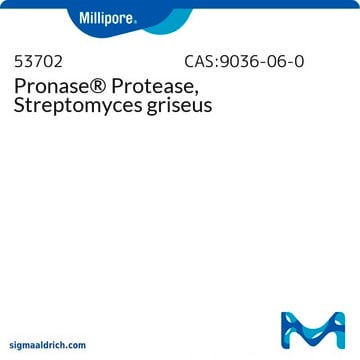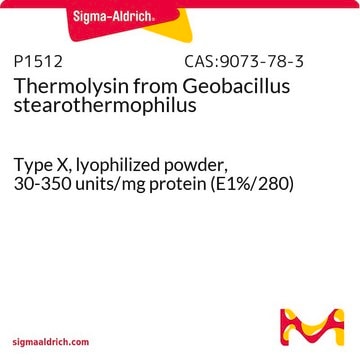537088
Pronase® Protease, Streptomyces griseus, Nuclease-Free
Widely used broad-spectrum protease mixture
Synonym(s):
Nuclease-Free Protease, Streptomyces griseus, Pronase® Protease, Pronase® Protease, Streptomyces griseus
About This Item
Recommended Products
form
lyophilized
specific activity
≥70,000 proteolytic units/g dry wt
manufacturer/tradename
Calbiochem®
storage condition
OK to freeze
solubility
water: 10 mg/mL
foreign activity
Nuclease, none detected
shipped in
ambient
storage temp.
2-8°C
General description
Application
- in single-cell preparations for cardiac side population (CSP) analysis
- in aflatoxin plasma biomarker assay
- to permeabilize Caenorhabditis elegans embryo for in vivo micrococcal nuclease digestion
Biochem/physiol Actions
Warning
Unit Definition
Reconstitution
Other Notes
Legal Information
Signal Word
Danger
Hazard Statements
Precautionary Statements
Hazard Classifications
Eye Irrit. 2 - Resp. Sens. 1 - Skin Irrit. 2 - STOT SE 3
Target Organs
Respiratory system
Storage Class Code
11 - Combustible Solids
WGK
WGK 2
Certificates of Analysis (COA)
Search for Certificates of Analysis (COA) by entering the products Lot/Batch Number. Lot and Batch Numbers can be found on a product’s label following the words ‘Lot’ or ‘Batch’.
Already Own This Product?
Find documentation for the products that you have recently purchased in the Document Library.
Customers Also Viewed
Our team of scientists has experience in all areas of research including Life Science, Material Science, Chemical Synthesis, Chromatography, Analytical and many others.
Contact Technical Service
















